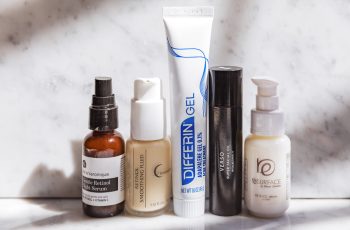Pumpkin Seed Oil in Skin Care Products
Pumpkin seed oil is an ingredient bursting with nourishing vitamins, essential fatty acids and antioxidants. Pumpkin seed oil has emerged as a natural powerhouse for moisturized skin and lustrous hair. This cold-pressed oil contains beneficial linoleic acid, vitamin E, vitamin A, zinc and other skin-healthy compounds to hydrate, calm and restore. Keep reading to find out if pumpkin seed oil is right for your daily skin care regimen.
Best Products With Pumpkin Seed Oil
What is Pumpkin Seed Oil Made of?
The compounds found in pumpkin seed oil contribute to it being a good anti-inflammatory, barrier repairing ingredient in skin care. There are antioxidants and hydrating fatty acids present in this ingredient. Here’s a detailed look at the most significant compounds in pumpkin seed oil: (3.4)
Linoleic Acid: A fatty acid vital for healthy skin barrier function and hair growth. Used in countless products as an anti-inflammatory ingredient.
Oleic Acid: A fatty acid that assists in the absorption of other ingredients.
Palmitic acid: A thick, saturated fat that locks moisture onto the skin. A comedogenic compound.
Stearic acid: A saturated fatty acid with occlusive properties, and is useful for barrier repair.
Vitamin E: repairs skin damage and protects from UV radiation. a potent antioxidant
Vitamin A (retinol): supports new cell turnover for youthful-looking skin. One of the most common ingredients for anti-aging and acne treatments.
Vitamin C: stimulates collagen and brightens complexion. Another potent antioxidant.
Zinc: regulates oil production, soothes acne and scalp conditions.
Magnesium: reduces inflammation that can lead to skin issues like eczema.
benefits of pumpkin seed oil
Benefits of Pumpkin Seed Oil
Pumpkin seed oil has many benefits in skin care thanks to its rich composition of fatty acids, vitamins, minerals and other compounds that protect and hydrate skin. One of its major benefits is moisturizing dry, flaky skin to restore supple softness. The oleic and linoleic fatty acids act as emollients to reinforce the skin’s moisture barrier while vitamin E and zinc strengthen overall skin health.
Another benefit is minimizing signs of aging like wrinkles and dark spots through pumpkin seed oil’s antioxidants including vitamin E, carotenoids and polyphenols. (1) These compounds neutralize free radicals to prevent their damage to skin cells and collagen. The oil also aids in exfoliation through vitamin A to give skin a vibrant, youthful tone.
Pumpkin seed oil also works wonders relieving inflammatory skin conditions like eczema, psoriasis and acne. Its anti-inflammatory activity calms flare-ups and redness while antibacterial properties protect acne-prone skin. The oil’s vitamins and minerals also speed healing for scars and blemishes, restoring smooth, clear skin.
With the ability to hydrate, protect, renew and soothe skin in so many ways, pumpkin seed oil is often used as an addition to face oils, serums, creams or masks. Take the skin type quiz to see if this ingredient is right for your skin type!
Side-effects
When it comes to potential side effects of pumpkin seed oil in skin care, the main concern is its comedogenic rating and risk of clogged pores for those with acne-prone skin. While pumpkin seed oil provides many benefits thanks to its rich nutrient profile, it does come with cautions regarding comedogenicity.
Pumpkin seed oil earns a 2-3 on the 0-5 comedogenic scale, with 0 being non-comedogenic and 5 being highly pore-clogging. (2)
Those with oily, acne-prone skin are most likely to experience breakouts, blackheads or whiteheads when using pumpkin seed oil, especially on the face. The oil essentially provides excess sebum that blocks pores and creates the ideal environment for acne-causing bacteria. Some people may also react negatively to topical application of pumpkin seed oil due to an allergy.
That said, not everyone with acne-prone skin will clog from or react to pumpkin seed oil. Using smaller amounts thoroughly mixed into creams or cleansers can allow managing any side effects. But knowing pumpkin seed oil’s comedogenic rating provides an important caution for those prone to congestion or sensitivity. As with any new skin care ingredient, patch testing for allergies is critical. Make sure pumpkin seed oil is safe for your skin type before including it in your daily regimen!
Which Skin Types Should Use Pumpkin Seed Oil?
For dry or maturing skin, this nutrient-dense oil makes an excellent addition to daily regimens. (2) While most skin types can take advantage of pumpkin seed oil’s benefits with careful use, those with very oily or acne-prone skin need to exercise more caution due to comedogenicity concerns. This ingredient is best for skin types who are not prone to acne. The best way to know if this ingredient is right for your skin type is to take our quiz and look for your skin type octagon on our product pages.
Pumpkin Seed Oil for Hair Care
Pumpkin seed oil is very popular in hair care routines because it contains many beneficial fatty acids for hair health. Some of the benefits provided to hair from pumpkin seed oil include: (6,7)
Boosts Hair Growth: The nutrients in pumpkin seed oil, especially zinc and omega fatty acids, nourish hair follicles to stimulate growth. Using it in scalp treatments helps repair damage and revive thinning areas to promote thicker hair.
Reduces Hair Loss: Along with spurring new growth, pumpkin seed oil has been shown to reduce hair shedding as well. The minerals and antioxidants strengthen hair strands to prevent breakage-related hair loss as part of natural shedding.
Adds Shine: Linoleic acid smooths down the hair cuticle so light better reflects for increased shine and shimmer. Pumpkin seed oil’s emollient quality also gives hair a glossy look and supple feel.
Tames Frizz: The oleic and linoleic fatty acids control wild hair strands that lead to frizz and static. This helps keep pesky baby hairs under control for smoother, sleeker hairstyles that better hold styling.
Provides Heat Protection: Pumpkin seed oil coats hair to provide a thermal barrier before heat styling to minimize damage from hot tools. The oil’s nutrients also help repair existing damage from over-processing.
Keep in mind that if your face is prone to acne breakouts, so is your scalp. If you are prone to acne breakouts, using pumpkin seed oil on your hair can result in acne under your hair or on your forehead.
Conclusion
Pumpkin seed oil is a great ingredient for treating inflammation and dehydration, as well as offering some benefits in sun protection. The only drawback of this ingredient is it is slightly comedogenic, meaning it can clog the pores of acne-prone skin. If you are considering including pumpkin seed oil in your skin care routine, be sure it is right for your skin type to avoid acne breakouts!
DQH Knowledge drop: In your 20s, your skin cell turnover decreases. (Cell turnover is a key component in keeping your skin youthful.) You know what else slows down? Your collagen production. Starting in your 20s, collagen decreases by about 1 percent per year. Should you want to prevent fine lines and wrinkles, start by eliminating behaviors that contribute to premature aging. “If it’s bad for you, it’s bad for your skin,” says dermatologist Michel Somenek.
“Cigarette smoking reduces blood flow to the skin and causes premature wrinkling and a dull skin texture. Making the repeated pursed motion to inhale can also cause smoker’s lines. Alcohol and recreational drugs are toxins for the skin that damage its cellular structure and DNA,” Somenek tells us. “The faster you eliminate vices while you are young, the better chance your skin and body have to recuperate.” Also, adopting an anti-aging routine in your 20s is key. After all, the best offense is a good defense. We spoke to Somenek and experts Joshua Ross and Audrey Kunin to find out more.
Keep reading for the best anti-aging products for your 20s, according to skincare professionals.
Sunscreen
“We all know that the sun is the number one cause of skin aging and starting the prevention in your 20s is very important,” Ross says. “The majority of your sun damage won’t start to appear until you’re in your 30s, so don’t wait until you see it surface or you’ll be behind the curve. Stay ahead of it with a good-quality zinc-based sunscreen worn daily.”
Farmacy Green Defense Daily Mineral Sunscreen
An invisible sunscreen with SPF 30, plus botanical extracts meant to protect skin with tons of antioxidants. Bonus: It’s clean and fine to use under makeup.
Bareminerals Complexion Rescue™ Tinted Moisturizer Broad Spectrum SPF 30
Although we recommend you use your SPF and moisturizer separately, we also understand moments when you don’t have time or energy for that extra step. For those times, this bareMinerals moisturizer is a great thing to have on hand.
Vitamin C Serum
“A great introduction to anti-aging is to start with a vitamin C serum in your morning skincare routine,” Ross says. “It’s a powerful antioxidant that will neutralize free radicals and brighten the skin.” He adds that it’s a great way to counteract the effects of the sun’s harmful rays, which, as previously mentioned, are among the biggest causes of premature aging.
Drunk Elephant C-Firma™ Vitamin C Day Serum
The Drunk Elephant C-Firma is a lightweight serum that promises to give skin a glow by combining the brightening powers of vitamin C with ferulic acid, l-ascorbic acid, and vitamin E. The included sodium hyaluronate is meant to replace hydration loss, so you shouldn’t have to deal with any irritation.
Sunday Riley C.E.O. Rapid Flash Brightening Serum
This potent serum is jam-packed with vitamin C (15 percent, to be exact), which means it’s a potential superstar at both brightening skin and dousing it in antioxidants.
Peptides
Using peptides on your skin has many benefits, says Somenek. “The skin barrier is what defends the body against pollution, UV rays, bacteria, and toxins. It can be damaged by several everyday factors. Using topical peptides aids in building a stronger barrier,” he says. “Peptides comprise elastic fibers, which are a type of protein. These fibers help to make skin appear taut and firm. Peptides can also help repair damaged skin, relieve inflammation, and even out skin tone. Some peptides can kill acne-causing bacteria that is common in 20-somethings.”
Kunin agrees, saying, “Peptides are an excellent entry point for supporting collagen.” She recommends looking for face and eye treatments that contain these collagen-boosting powerhouses.
Charlotte Tilbury Magic Eye Rescue Cream
This Charlotte Tilbury super-emollient eye cream has a base of coconut oil and shea butter (read: it’s incredibly hydrating). Botanicals plus peptides are meant to help reduce dark circles and boost collagen, respectively.
This creamy moisturizer serves up potent collagen-boosting peptides and pycnogenol, and antioxidant-rich vitamin C. “Instead of sitting on top of the skin, peptides penetrate the outer layer so they go deep. The ‘signals’ they send tell the cells to produce elastin and collagen, which are needed for youthful-looking skin,” explains Somenek.
At-Home Peel Pads
Remember that skin cell turnover fiasco we talked about earlier? One way to help support it is by exfoliating. “Exfoliation is important to help keep skin fresh and luminous,” Kunin says. She recommends using at-home peel pads as an easy and effective way to exfoliate.
“The goal in your 20s is to fight the slowing pace of cell turnover. It is wise to use products that gently exfoliate, yet still remove oil and other impurities. Products that have Alpha Hydroxy Acids (AHA) or Beta Hydroxy Acids (BHA) are a good choice.”
According to Somenek, you should only exfoliate two to three times a week. “People of all ages are guilty of over-exfoliating and that can be too much of a good thing,” he says.
Dermadoctor Kakadu C Intensive Vitamin C Peel Pad
A few swipes of this Derma Doctor powerful peel pad promise to leave your skin glowing and smooth, thanks to the seven (yes, seven) types of chemical exfoliants, including AHA and BHA. It also contains vitamin C via Kakadu plum extract for added brightening and antioxidant protection.
KEY INGREDIENTS Kakadu plum extract is sourced from the Kakadu plum, a fruit grown in northern Australia. It contains vitamin C, which restores the skin’s natural barrier, increases collagen production, and soothes irritation.
Dr. Dennis Gross Skincare Alpha Beta® Universal Daily Peel Pads
These are the gold standard of peel pads, with a cult following and over 900 five-star reviews on Sephora. They’re easy to use and contain a blend of anti-aging exfoliating acids.
Emollient Night Cream
“In your 20s, you need to start upping the hydration in your skincare routine. You may have been cautious of over-moisturizing because of acne in your teens, but as you enter your 20s, your skin transitions and becomes drier,” Ross says. “I recommend an emollient night cream added into your evening skincare regimen.”
“Twenty-somethings need to make sure that they are not using creams that will clog their pores and cause excess oil production,” says Somenek. Opt for non-comedogenic products.
Cerave Skin Renewing Night Cream
One great choice is the CeraVe Skin Renewing Night Cream, which is a non-comedogenic night cream that leaves skin soft and glowy. It combines the moisturizing powers of ceramides and hyaluronic acid.
RoC Retinol Correxion Max Hydration Creme
“The best night cream ingredients contain retinol, benzoyl peroxide, and/or salicylic acid or hyaluronic acid. The goal is to moisturize, yet remove excess oil,” says Somenek. This Roc Retinol Correxion cream fits the bill as it contains both hyaluronic acid and retinol so it promises to moisturize while also being non-comedogenic.



